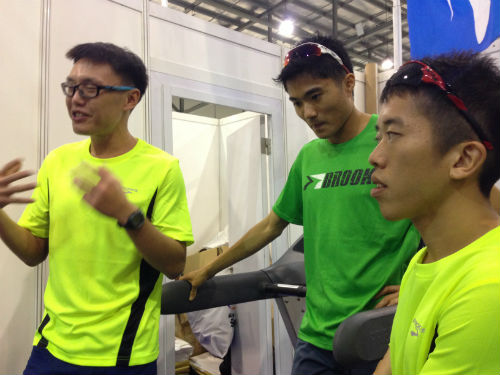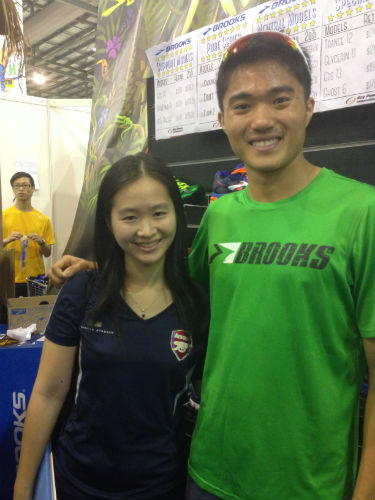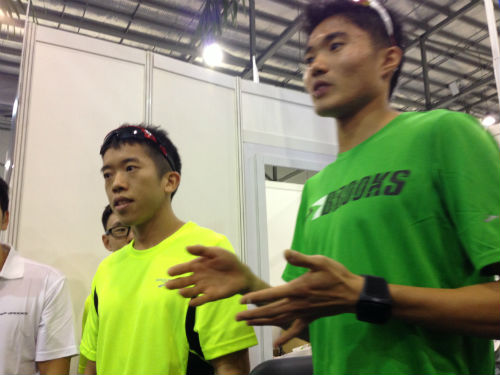This afternoon, Singapore’s top marathoner and medical doctor, Mok Ying Ren was on hand at the Singapore Expo to give runners some informal last-minute tips on the 2013 Standard Chartered Marathon to calm their nerves before the big race tomorrow. These tips were in the form of questions and answers from the audience.
Mok, who will be taking part in the Standard chartered 42km marathon, as training for his SEA Games marathon later this month, was there with fellow distance runners Ivan Low and Derek Li for the session, organized by Brooks Running.
For tips on tomorrow’s big race, do read on.
What if I cannot sleep the day before the race?
Mok: It is common to have sleeping issues the day before your race. So that is perfectly okay. Just try your best to sleep. As long have you have had a good night’s rest in the week leading to your race, the adrenaline on race day should help to keep you going.
Derek: Getting eight hours of sleep is of course the optimum, but because of the excitement if the race, most of us probably won’t be able to get that.
What types of food should I eat?
Mok: You should eat a carb-heavy dinner the night before your race. We would usually go for pasta. In fact, we’re going to have Pastamania tonight!
Derek: Try and go for nutritious food with little fat and high carbs. For me, I usually have digestion issues before the race so I go for a liquid diet. That comprises of fluids and not solid food after lunch. However I need the calories, so I would go for fruit juices and isotonic drinks. I won’t have milk though because its quite hard for me to digest. To make up for it though, I would make sure I have a heavy lunch comprising of plenty of carbs.
Ivan: As for me, my diet will comprise of 50 per cent carbs, 20 per cent proteins and very little fats, because they are hard to digest and I don’t want to fall sick on the race day.
How should we eat and hydrate ourselves on race day itself?
Mok: Tomorrow morning, on the day of the race, I recommend waking up at 3am (marathon flags off at 5am) and drinking 500ml to 1 litre of water.
For food, I would take a packet of energy gels and eat some bread or cereals so that I won’t feel hungry during the run. However don’t eat too much food or you will get cramps though.
Then about half an hour before the actual race, I would then take another energy gel so that I will have enough energy for the race itself.
Derek: Usually I will take a gel in the morning and a fruit juice straight after that. Then up to one hour before the race, I will take 500ml of water. It is quite easy to over drink because your mouth gets quite parched, but you will have to try and control yourself.
Ivan: For me, breakfast usually consists of a banana and toast with peanut butter or Nutella. I make sure I wake up at least two hours early in order to digest the food.
What if I get hungry during the race?
Mok: For us, energy gels usually keep us full, but if you feel as though this is not enough, then you can try energy bars. Take an energy bar after every two hours of running, in addition to the gels, and that should help to satisfy your stomach until you have completed the race. That is, if you are doing a four to six hour marathon.
How do you prepare for the race?
Mok: I make sure I prepare everything the night before. In the morning, remember to apply Vaseline on the parts of the body that are prone to chaffing. To me, warming up exercises are not that important if you are racing in a hot climate like Singapore because the body is already warmed up from the heat. But there is no harm in doing five minutes of warm-up exercises.
But of course, try and bring a disposable poncho just in case it rains, if rain had been predicted for the day.
What happens if you have stomach cramps during the race?
Mok: The most common reason why people may get stomach cramps during races is that they start too fast. So if you are prone to stomach cramp, try to do a few warm-up exercises to warm up your stomach area.
If you are running at the right pace, the run should not feel hard at all. In fact it should feel very easy. To help you maintain your desired pace, try and get a pace band to wear at the start of the race so that you can stick to your desired timing.
Also to avoid cramps, it is recommended that you take water from every hydration station along your race route. For energy gels, take them after every 45 minutes after the start of the race. But to prevent cramps, take water at that particular hydration station if you are taking a gel, do not take isotonic drinks because the sugar in the drink will react with the gel to cause cramps.
When you are switched off, your pace should be easy and you should feel good about the running. For example slow down when you are heading uphill. The reasons why you get cramps is because the muscles need energy to relax but if they are not getting that, they may cramp up. So whenever you are beginning to feel the onset of cramp, you should slow down your pacing and do not let the cramp go full-on otherwise it will be hard to recover from it already. Drinking salt water the day before the race may also help prevent cramps for some.
Ivan: Try to also take 100 PLUS or any other isotonic drink the night before your race. This may also help to prevent cramping issues.
How should you drink at water stations?
Answered by all: Basically just drink when you feel thirsty. Listen to your body telling you as and when to drink. Do not drink to schedule. That won’t work. Also, it helps to pour water over your head if you really cannot drink another drop, but you are feeling hot and may think that you need to cool down. It’s really no point stuffing yourself up with water.
When you are drinking at water stations, you actually slow down at them a lot less than you think you are. For example if you stop 10 seconds per water station, and there are 30 water stations altogether, you are only adding 3 minutes to your race time and for a four to five hour marathon, that isn’t very much time taken at all.
Of course though, if you drink too much water, it will cause problems such as stitches, so just keep it to one cup per water station. But between drinking water versus isotonic drinks, the isotonic beverages actually contain sugars which help to energise you more as you run whereas water does not. But the choice is entirely up to you.
What happens when you hit the wall and are dead tired after about 35km of running?
Mok: Well if you are so tired that you can’t move any more, you have either undertrained or you started way too fast and you are paying for it now. But if you start out at a conservative pace and your nutrition strategy was correct, then you should encounter much less problems. But of course it takes time and experience to figure out your optimum pace though.
Ivan: I still remember my first marathon where I hit the wall about 30 plus kilometres in. That was really tough and I really couldn’t run any more.
If you are training for a marathon what is the optimum pacing for short training runs?
Answered by all: It depends on the person but a good pace should reflect 80 per cent of your maximum heart rate. As you come nearer to the race, try to use speed workouts in pacing. For example, doing a four min per km pace intervals should be good for a 10KM distance for more experienced runners who want to improve their timing.
How do you work to increasing your pace in running?
Answered by all: The long runs will help you gradually improve your pace as a runner because they build endurance. Over time, your speed will also become faster. The marathon is such a long race; a good pace to go at during your training sessions would be at your half marathon pace and perhaps slow down a little bit so that you will be able to last the distances come race day.
What type of training is actually best for marathon runners?
Answered by all: They all have their pros and cons so no one type of training is better than another.
For hill repeats, they make your legs stronger but the long distance runs help to build up your overall endurance capacity. Strength training such as squats and push ups help to build up the core body, which is also essential for runners. But you must work out both the front and back core muscles; many runners make the mistake of exercising the front side but not the back side of the body.
Do compression tights work?
Mok: For recovery, I definitely recommend them. It is an ongoing debate but I guess it’s just how you feel about them. But I believe in them for the recovery phase because they help to hold the injured muscles together and this aids in healing. However there is no research actually done that signifies that compression tights can bring about an improvement in your race performance though.
What is the best recovery drink for runners?
Mok: Definitely chocolate milk! It contains carbs and protein – and it’s tasty too!
What is the longest run that you should do to train for a marathon?
Answered by all: It should be around the range of 31km to 33km. (Mok himself does 38km runs in training to prepare himself for the marathon).
What happens if you get stitches while running?
Answered by all: You should take a deep breath and slow down the speed that you have been running at.
More Running Tips
- Mok’s Tips on Pacing and Tips on Recovery
- Anne Qi Hui’s Tips for Standchart
- Are you Ready to Run A Marathon?
- Training For A Marathon
- How to Run Faster




Leave a Comment